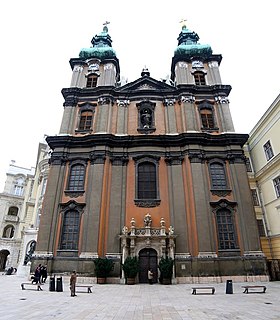 W
WDistrict V is the heart of Budapest and the political, financial, commercial and touristic center of Hungary. The name of the district is Belváros-Lipótváros, which refers to the two historical neighbourhoods that is located in the district; Belváros and Lipótváros . Inner City is the old town of Pest, while Leopold Town was established in the early 19th century, and became the political and financial centre of Hungary in the early 20th century when the Hungarian Parliament was built. The two neighbourhoods were originally the 4th and 5th districts of Budapest until 1950 when the two districts were merged and number IV was given to Újpest.
 W
WBatthyány's sanctuary lamp is a national monument, located at the corner of Báthory Street and Hold Street in Lipótváros, Budapest, Hungary. It sits on the former location of the courtyard of the New Building, where Count Lajos Batthyány (1807–1849), the first Prime Minister of Hungary, was executed on 6th October 1849.
 W
WBudapest Stock Exchange (BSE) is the 2nd largest stock exchange in Central and Eastern Europe by market capitalization and liquidity. It is located at 7 Liberty Square, Budapest, Hungary, in the central business district of the city, known as District V. Previously, from 1864, during the Austro-Hungarian Empire it was located in the Budapest Stock Exchange Palace building, until a large trading floor was necessary. The exchange is controlled by listed issuers, by Hungarian private investors and by the central bank. The BSE is member of the World Federation of Exchanges and the Federation of European Securities Exchanges.
 W
WThe Church of St Mary the Virgin, commonly known as the University Church is a Catholic Church in the Papnövelde Street, Belváros-Lipótváros District in Budapest, Hungary. From 1786 the church belongs to the former Theological Faculty of the Eötvös Loránd University, and to the Pázmány Péter Catholic University independent of it; before it was the central church of the Pauline Order. The Central Priestly Educational Institute operates in a block adjacent to the church, so that the liturgical services of the church are performed by the priestly students and the chiefs of the institute. The church has two towers and its towers are 56 meters high.
 W
WThe Museum of Ethnography is a national museum in Budapest, Hungary.
 W
WThe F-4 Object is a formerly secret nuclear shelter under the downtown of Budapest. It is located 45-50 metres below the surface, several kilometres long approximately in a "H" shape between Kossuth tér and Szabadság tér. It has a direct connection to the Line 2 of the Budapest Metro and a closed tunnel to the Hungarian Parliament Building. According to other sources, the bunker has a connection with the former headquarters of the Hungarian Working People's Party, and there is no tunnel to the Parliament Building.
 W
WCafé Gerbeaud, situated at Vörösmarty tér 7 in Budapest, the capital of Hungary, is a traditional coffeehouse opened in 1858. It was built in Gründerzeit style. In 2009 Café Gerbeaud opened its second confectionery in Tokyo, Japan.
 W
WInner City the central part of Budapest. It is more or less equivalent with the historic old town of Pest.
 W
WLiberty Square is a public square located in the Lipótváros neighborhood of Budapest, Hungary.
 W
WLipótváros is a traditional neighbourhood in the city centre of Budapest, named after King Leopold II. It is one of the two neighbourhoods of District V, the other one being Inner City (Belváros), which is the old town of Pest. Lipótváros was established in the early 19th century, and became the political and financial centre of Hungary in the early 20th century when the Parliament was built on Kossuth Square. Many ministries followed in the later decades. After the 1989 change Lipótváros gradually became again the business centre of Budapest with many banks and office buildings. The neighbourhood is rich in listed historic buildings and landmarks.
 W
WThe Memorial for Victims of the German Occupation is a monument created in memory of the German invasion of Hungary, located in Budapest's Liberty Square. The memorial has sparked controversy and angered Jewish community organizations, with critics alleging that the monument absolves the Hungarian state and Hungarians of their collaboration with Nazi Germany and complicity in the Holocaust.
 W
WThe New Building was a fortress located in Pest as a jail. The construction began under the direction of János Hild, the father of József Hild and dissolved in 1897, it became the nickname the Hungarian Bastille. Found on his old footprint the current Szabadság tér.
 W
WThe Széchenyi Chain Bridge is a chain bridge that spans the River Danube between Buda and Pest, the western and eastern sides of Budapest, the capital of Hungary. Designed by English engineer William Tierney Clark and built by Scottish engineer Adam Clark, it was the first permanent bridge across the Danube in Hungary. It was opened in 1849. It is anchored on the Pest side of the river to Széchenyi Square, adjacent to the Gresham Palace and the Hungarian Academy of Sciences, and on the Buda side to Adam Clark Square, near the Zero Kilometre Stone and the lower end of the Castle Hill Funicular, leading to Buda Castle.